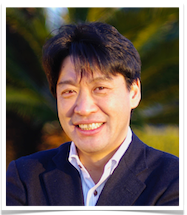Kenichiro Itami (born in 1971) is an organic chemist in Japan.
He received his Ph.D.from Kyoto University under the guidance of Prof. Yoshihiko Ito. In 1998, he began his academic career at Kyoto University as an Assistant Professor (with Prof. Jun-ichi Yoshida). He moved to Nagoya University to become an Associate Professor (with Prof. Ryoji Noyori) in 2005, and was promoted to Full Professor in 2008. In 2012, he became the Director of the WPI Institute of Transformative Bio-Molecules (ITbM) in Nagoya University. In 2013, he was selected as the Research Director of ERATO project supported by JST.
- Education
1994 B.S. in Chemistry, Kyoto University, Japan Advisor: Prof. Hisanobu Ogoshi
1996 M.S. Graduate Student in Chemistry Kyoto University, Japan Advisor: Prof. Yoshihiko Ito
1998 Ph.D. Graduate Student in Chemistry, Kyoto University, Japan Advisor: Prof. Yoshihiko Ito
1996~1998 JSPS Research Fellowship for Young Scientists
1997~1998 Exchange Student, Uppsala University, Sweden (Prof. Jan-E. Bäckvall)
- Academic Career
1998 Assistant Professor, Kyoto University (with Prof. Jun-ichi Yoshida)
2005 Associate Professor, Nagoya University (with Prof. Ryoji Noyori)
2005~2009 JST, PRESTO, Researcher
2008~present Professor, Department of Chemistry, Graduate School of Science, Nagoya University
2012~present Director, Institute of Transformative Bio-Molecules (WPI-ITbM),1 Nagoya University
2013~present Research Director, JST, ERATO,2 Itami Molecular Nanocarbon Project
- Awards and Honors
2014 Nankai University Lectureship Award
2013 Novartis Chemistry Lectureship Award
2013 Mukaiyama Award
2013 Asian Rising Star Award, Asian Chemical Congress
2012 Fellow of the Royal Society of Chemistry, UK
2012 German Innovation Award “Gottfried Wagener Prize 2012”
2012 Novartis-MIT Lectureship Award, MIT, USA
2011 ACP Lectureship Award, China
2011 ACP Lectureship Award, Malaysia
2011 Nozoe Memorial Award for Young Organic Chemists
2008 Merck-Banyu Lectureship Award
2007 Banyu Young Chemist Award
2006 Minister’s Award for Distinguished Young Scientists (MEXT)
2005 Mitsui Chemicals Catalysis Science Award of Encouragement
2005 The Chemical Society of Japan Award for Distinguished Young Chemists
2004 Thieme Journals Award
2000 Nissan Chemical Industries Award in Synthetic Organic Chemistry, Japan
- Research
The work of his group has centered on catalyst-enabling synthetic chemistry with broad directions. Representative projects include (1) development of new catalysts for C-H coupling, (2) synthesis and properties of bio-molecules, (3) synthesis and properties of new optoelectronic -materials, and (4) controlled synthesis of nanocarbons.
- Representative paper
1. A grossly warped nanographene and the consequences of multiple odd-membered-ring defects
Kawasumi, K.; Zhang, Q.; Segawa, Y.; Scott, L. T.; Itami, K. Nat. Chem 2013, 5, 739–744.
Graphite, the most stable form of elemental carbon, consists of pure carbon sheets stacked upon one another like reams of paper. Individual sheets, known as graphene, prefer planar geometries as a consequence of the hexagonal honeycomb-like arrangements of trigonal carbon atoms that comprise their two-dimensional networks. Defects in the form of non-hexagonal rings in such networks cause distortions away from planarity. Herein we report an extreme example of this phenomenon. A 26-ring C80H30 nanographene that incorporates five seven-membered rings and one five-membered ring embedded in a hexagonal lattice was synthesized by stepwise chemical methods, isolated, purified and fully characterized spectroscopically. Its grossly warped structure was revealed by single-crystal X-ray crystallography. An independent synthetic route to a freely soluble derivative of this new type of ‘nanocarbon’ is also reported. Experimental data reveal how the properties of such a large graphene subunit are affected by multiple odd-membered-ring defects.
2. Initiation of carbon nanotube growth by well-defined carbon nanorings
Omachi, H.; Nakayama, T.; Takahashi, E.; Segawa, Y.; Itami, K. Nat. Chem. 2013, 5, 572–576.
Carbon nanotubes (CNTs), tubular molecular entities that consist of sp2-hybridized carbon atoms, are currently produced as mixtures that contain tubes of various diameters and different sidewall structures. The electronic and optical properties of CNTs are determined by their diameters and sidewall structures and so a controlled synthesis of uniform-diameter, single-chirality CNTs—a significant chemical challenge—would provide access to pure samples with predictable properties. Here we report a rational bottom-up approach to synthesize structurally uniform CNTs using carbonnanorings (cycloparaphenylenes) as templates and ethanol as the carbon source. The average diameter of the CNTs formed is close to that of the carbon nanorings used, which supports the operation of a ‘growth-from-template’ mechanism in CNT formation. This bottom-up organic chemistry approach is intrinsically different from other conventional approaches to making CNTs and, if it can be optimized sufficiently, offers a route to the programmable synthesis of structurally uniform CNTs.
- Photo Gallery
- Related Links
Itami group Home page Itami's CV (PDF file) Angew. Chem. Int. Ed. Author Profile
- Related Books


